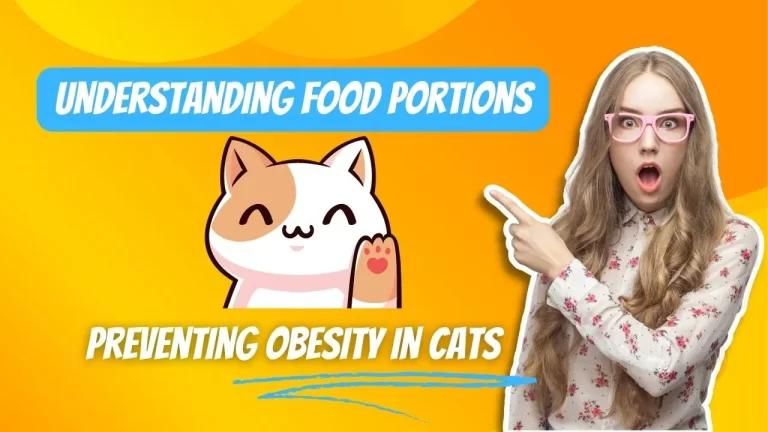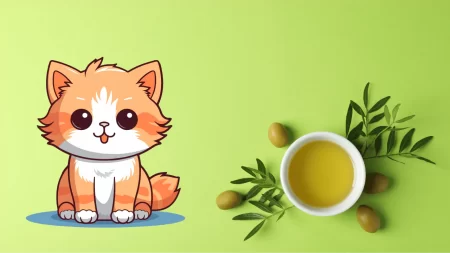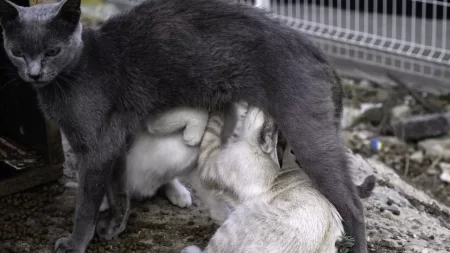Cats, as obligate carnivores, require a well-rounded and full diet for their well-being and contentment.
Nevertheless, numerous cats suffer from excessive feeding and insufficient physical activity, resulting in obesity and associated health complications.
This article aims to elucidate the significance of comprehending feline nutrition and regulating portion sizes.
It will offer advice on preventing obesity in cats and highlight the perils of overfeeding and obesity in felines.
The Importance of Understanding Feline Nutrition and Portion Control
Cats evolved as carnivorous hunters with a diet rich in protein, moderate in fat, and low in carbohydrates. Even today, cats require these proportions along with additional nutrients like vitamins, minerals, fatty acids, and amino acids.
However, many commercial cat foods deviate from these natural requirements. Some cat foods have excessive carbohydrates, leading to weight gain and diabetes. Others contain low-quality ingredients and additives that affect taste and digestion. Feeding methods also impact feline nutrition.
Free-choice feeding, where food is always available, can result in overeating and obesity, particularly with calorie-dense food and inactive cats. Moreover, it becomes challenging to monitor intake and appetite, which are vital health indicators.
Hence, cat owners must comprehend their cats’ nutritional needs, select appropriate food types and quality ingredients, and control portion size and feeding frequency based on age, weight, and activity level.
The Role of Carbohydrates in a Cat’s Diet
Carbohydrates are a source of energy for cats, but they are not essential for their survival. Cats can produce glucose from protein and fat through a process called gluconeogenesis. However, some carbohydrates can be beneficial for cats, such as fiber, which can help with digestion and hairball prevention.
The optimal amount of carbohydrates for cats is not well established, but some experts suggest that it should be less than 10% of their daily caloric intake. However, many dry cat foods contain more than 30% carbohydrates, which can exceed the cat’s capacity to metabolize them. Excess carbohydrates can be stored as fat in the body, leading to obesity and diabetes.
Therefore, cat owners should check the label of the cat food they buy and look for products that have high-quality protein sources as the first ingredient, and low amounts of carbohydrates. They should also avoid products that have corn, wheat, soy, or other grains as fillers or byproducts.
The Impact of Free Feeding on a Cat’s Health
Cats who are allowed to freely feed may face several negative consequences. These include overeating and becoming obese, as they might consume more than necessary out of boredom or habit, especially if the food is tasty or high in calories.
This can result in various health problems such as diabetes, arthritis, urinary tract infections, and liver disease.
Additionally, owners may struggle to monitor their cat’s appetite, making it difficult to identify signs of illness or stress.
Changes in appetite can also impact medication or insulin dosage for diabetic cats. Moreover, leaving food out for extended periods can attract pests, cause the food to spoil, and compromise its quality and safety.
Lastly, if there are multiple cats in the household, free feeding can lead to competition for food resources, fostering aggression and bullying behaviors among the cats. Some cats may overeat to prevent others from accessing the food, while others may eat less due to stress or fear.
Understanding the connection between portion control and obesity
Controlling portion size is crucial for preventing obesity in cats. It involves providing your cat with a measured amount of food at specific times during the day. This helps regulate your cat’s energy intake and expenditure, preventing overeating and weight gain.
Several factors determine the appropriate amount of food to feed your cat, including:
- Type and quality of the food: Different foods vary in caloric densities and nutrient profiles. For instance, dry food contains less water and more carbohydrates compared to wet food, resulting in higher calories per gram. The quality of ingredients also impacts food digestibility and palatability.
- Age, weight, and activity level of your cat: Younger, leaner, and more active cats require more calories than older, heavier, and less active cats. Your veterinarian or a body condition score chart can help determine your cat’s ideal body weight and condition.
- Health status and special needs of your cat: Certain medical conditions or dietary requirements influence a cat’s caloric needs. Diabetic cats, for example, benefit from a low-carbohydrate diet to manage blood sugar levels, while cats with kidney disease require a low-protein diet to ease kidney workload.
To determine the appropriate portion size, consult the feeding guidelines on the cat food label or seek advice from your veterinarian.
Use a measuring cup or scale to accurately measure the food and adjust as necessary based on your cat’s weight and body condition.
Tips for Preventing Obesity in Cats
Obesity is a serious health problem for many cats worldwide. It can lower your cat’s quality and length of life, and raise the risk of various diseases and complications. Luckily, you can prevent and manage obesity by following some simple tips:
- Pick the right food type and quality ingredients for your cat: Look for cat foods that have high-quality protein sources first, and low amounts of carbohydrates, fillers, or byproducts. Avoid foods that have artificial colors, flavors, or preservatives. You can also try wet foods or raw foods that have more moisture and fewer calories than dry foods.
- Set a feeding schedule and portion sizes based on age, weight, and activity level: Feed your cat a measured amount of food at set times, preferably twice a day. Avoid free-choice feeding or leaving food out for a long. Change the portion size as needed based on your cat’s weight and body condition. You can use a measuring cup or a scale for accuracy.
- Watch your cat’s weight and body condition: Weigh your cat often and check his or her body condition score using a chart or your veterinarian’s advice. A healthy cat should have a visible waistline from above and a slight abdominal tuck from the side. You should feel but not see his or her ribs, spine, and hip bones. If your cat is overweight or obese, you should ask your veterinarian for a weight loss plan.
- Add exercise and playtime to your cat’s routine: Exercise is vital for keeping a healthy weight and avoiding obesity in cats. It also gives mental stimulation and enrichment for your cat and strengthens your bond. You should aim for at least 15 minutes of playtime with your cat every day, using toys that mimic prey movements, such as feathers, balls, or lasers. You can also make your cat more active by giving him or her scratching posts, climbing trees, tunnels, or window perches.
- Skip table scraps and human food: Human foods are not good for cats, as they may have ingredients that are toxic or bad for them, such as onions, garlic, chocolate, grapes, raisins, or xylitol. They may also have too much salt, sugar, fat, or calories for your cat’s needs. Giving table scraps or human food to your cat can cause digestive upset, obesity, diabetes, or other health problems. It can also create bad habits and spoil your cat’s appetite for his or her regular food.
The Dangers of Overfeeding and Obesity in Cats
Overfeeding is the main cause of obesity in cats. It means giving your cat more food than he or she needs for energy.
Overfeeding can happen from free-choice feeding, too large portions, too frequent feeding, high-calorie foods, table scraps, or human food, or feeding out of guilt or love.
Obesity is when excess body fat builds up in the body and harms the health and well-being of the animal.
Obesity is having a body weight that is 20% or more over the ideal weight for the animal’s size and breed.
Obesity can cause serious problems for your cat’s health, such as:
Obesity can raise your cat’s risk of serious health issues, such as:
- Diabetes mellitus: Obesity makes your cat secrete more insulin to lower the blood glucose level in overweight cats. But over time, the cat’s body resists insulin, resulting in high blood sugar levels and diabetes. Diabetes can cause complications, such as nerve damage, kidney failure, infections, and blindness.
- Arthritis and lameness: Obesity stresses the joints and cartilage of your cat, causing inflammation and degeneration. This can cause pain, stiffness, reduced mobility, and lameness in your cat. Arthritis can also affect your cat’s quality of life and behavior, making him or her less active, playful, or social.
- Heart disease and hypertension: Obesity affects your cat’s cardiovascular system, increasing the work on the heart and blood vessels. This can lead to high blood pressure (hypertension), which can damage the organs and tissues of your cat. Obesity can also cause heart diseases, such as cardiomyopathy or heart failure, which can lower the blood flow and oxygen delivery to your cat’s body.
- Urinary tract infections and stones: Obesity can raise the risk of urinary tract infections (UTIs) and urinary stones in cats. UTIs are caused by bacteria that enter the urinary tract and cause inflammation and pain. Urinary stones are solid deposits that form in the bladder or urethra and can block urine flow. Both conditions can cause symptoms such as straining to urinate, blood in the urine, or frequent urination. They can also cause more serious problems, such as kidney damage or bladder rupture.
- Skin problems: Obesity can harm your cat’s skin health, making it more prone to infections, allergies, or parasites. Obese cats may have trouble grooming themselves properly, resulting in mats, dandruff, or odor. They may also develop skin folds that trap moisture and bacteria, causing irritation and infection.
- Anesthetic complications: Obesity can raise the risk of complications during anesthesia and surgery in cats. Obese cats may have trouble breathing or keeping their body temperature under anesthesia. They may also have a higher chance of bleeding or infection during or after surgery. Obese cats may also need longer recovery times and more intensive care than normal-weight cats.
How to identify and address obesity in cats: The first step in identifying obesity in cats is to weigh them regularly and check their body condition score using a chart or your veterinarian’s guidance.
If your cat is overweight or obese, you should consult your veterinarian for a weight loss plan that suits your cat’s needs. A weight loss plan may include:
- Reducing the caloric intake of your cat by feeding a lower-calorie food or a smaller portion size.
- Increasing the physical activity of your cat by providing toys, games, or interactive play sessions.
- Monitoring your cat’s progress by weighing him or her every two weeks and adjusting the plan as needed.
- Seeking professional advice from your veterinarian if you encounter any problems or concerns during the weight loss process.
Conclusion
Obesity is a common and preventable problem in cats that can have serious consequences for their health and well-being.
To help your cat achieve and maintain a healthy weight while preventing obesity-related diseases, it is important to comprehend feline nutrition and portion control.
Choose the appropriate food type and quality ingredients for your cat, and establish a feeding schedule and portion sizes based on age, weight, and activity level.
Monitor your cat’s weight and body condition regularly and include exercise and playtime in their routine. Avoid giving table scraps and human food. If necessary, consult your veterinarian for a weight loss plan.







